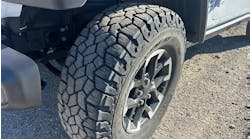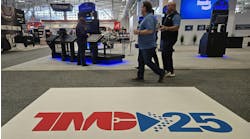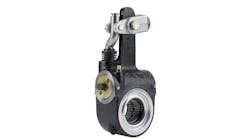Penske augments trainers with HoloLens to mold more skilled technicians
As one of North America’s largest fleets, with 350,000+ vehicles, Penske Truck Leasing must also employ a huge pool of maintenance technicians, about 8,700 in all. Due to the natural attrition of the trade, Penske must train hundreds of new technicians per year, the company said, and that falls on the shoulders of 37 trainers. To increase the impact and scope of these training sessions, those instructors are now donning Microsoft HoloLens 2 devices on their heads, unlocking the power of augmented reality and giving trainees a first-person view of a training tasks. And they reach several trainees at a time, who are watching the instructor on the XRMentor platform from a smart device or laptop.
“AR training allows us to provide very specific skill building events with a one-to-many approach,” said Holly Gerke, vice president of technical training and development, Penske Truck Leasing, to Fleet Maintenance. “We can give opportunities to technicians to sharpen their craft using a live instructor-led experience, and that's really very impactful.”
The HoloLens 2 device was designed for industrial applications, and is also used at the OEM level, such as with Paccar. Oftentimes, each trainee might use a HoloLens, but Penske went in a different direction.
“We wanted to maximize that investment, so instead of putting the HoloLens in the hands of the technicians, we are putting the HoloLens on the heads of our trainers,” Gerke said.
The first lesson is an entry-level air disc brake wheel-off inspection.
“There's a lot of compliance and safety concerns with brakes, so we wanted an opportunity to get in front of our technicians more quickly than we have been before, so the procedure is very simple,” said Gerke who added the training focuses on a specific skill and is distilled down to six steps.
Via customized lessons running through Design Interactive’s XRMentor (formerly AUGMENTOR) software, the trainers share their point-of-view in real time, describing how to check proper spacing between the rotor and pad, or how to spot excessive wear on the pad, for example. Those are supplemented with Penske-made videos and pictures. Following the roughly 45-minute lessons, the trainees perform the same task on a pre-staged truck at their location, following specific OEM-recommended work instructions.Gerke noted the videos and online courses Penske was already doing bared noticeable productivity gains, but this up-close instruction paired with practical training more securely deposits the training in the technicians’ memory banks.
“What we're trying to do is initiate the idea of repetition; that's how entry-level technicians really do learn,” Gerke said. “It's not a once-and-done, it's not just reading and doing—it's actually this dynamic transfer of information and seeing someone else do it.”
Furthermore, trainees can jump in and ask questions at any time, Gerke said. Instructors also can audit how each technician replicated the task they were just shown, ensuring they acquired the new skill.
“They report back into the instructor during the AR session to talk about what they experienced, and the trainer has an opportunity to make sure you're actually applying that skill correctly,” Gerke explained.
“The approach that Penske’s taking is quite innovative compared to what we see in other industries,” said Matt Johnston, commercial solutions director, Design Interactive. The company has worked closely with the trucking maintenance field for the last few years, including the American Trucking Associations’ Technology & Maintenance Council on gamification projects.
Johnston said even though it’s being deployed by such a huge fleet, it’s also “really the right thing for those who happen to be smaller.” In a company with fewer than 300 technicians for example and perhaps three or four trainers, maybe even only one, using this method deployed by Penske allows training methods on new equipment or updated procedural information to quickly disseminate to 15 or 20 dealerships.
And each person has a front-row seat to the action, even when the trainer goes into the pit and under chassis. During a wheel-on or wheel off, the trainer’s own body is included in what the live, in-person audience would see, Johnston said, adding “But now, people can actually see exactly what you're doing in a high resolution that they can't get even when they're live, and then have the chance to immediately do it themselves.”
Furthermore, the company pays for the software licensing and fees and HoloLens, as opposed to air fare, lodging, and catering for the trainees.
“How much money they spend to bring technicians in for a live event, and then they don't get that up-close experience that you might even expect,” Johnston said.
He also added this method “can make an impact on their entire organization very quickly, by comparison to having to deploy a headset per facility per technician, and ultimately turn themselves into an IT department.”
Gerke said one key element is teaching the instructors to remain engaging throughout the training, as well as teaching them how to use the HoloLens. This may take around two days, and Gerke and Johnston both noted that that age was less of a factor of picking up how to use the sophisticated technology, but rather their mindset, because the device is so intuitive, with images popping up via specific hand gestures.
“And that's what are our trainers and essentially our technicians are very good at doing: using their hands,” Gerke said.
Ernie Luzania, manager of technical training at Penske, had never worked with AR before, but he and his team have embraced the new training solution.
“I enjoy the information gap that it can help bridge between traditional instruction and the new generation of learners,” said Luzania, who has been with Penske for 14 years and in the industry for 24. “We are going to use tools they like and are comfortable with for effective information delivery. For the rest of us, we get to play in a new sandbox as well, which can be very stimulating.”
He said as more trainers are onboarded to the HoloLens method, “they have already taken ownership and offered improvements which we will pass along.”
Most important to any lesson plan are that students learn and retain the knowledge passed down, and Luzania said at least for the brake inspection class, that was accomplished: “They all felt the class was created and delivered for them; they felt it was very personal, as in one-on-one.”







